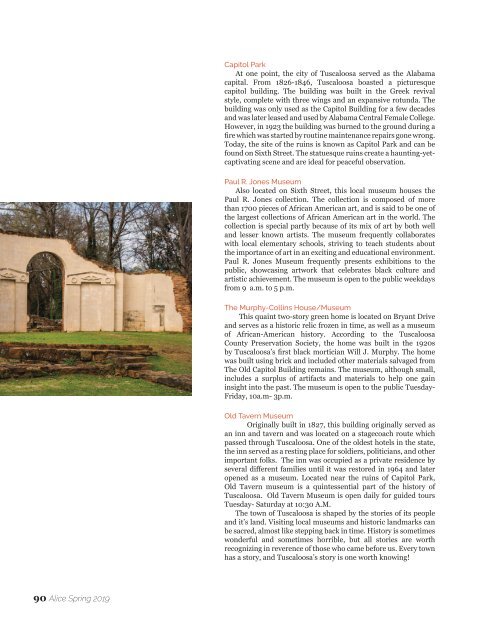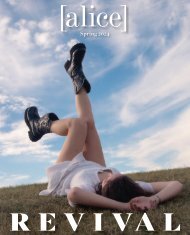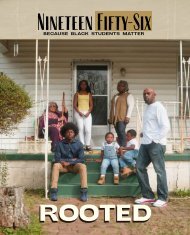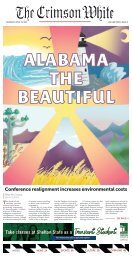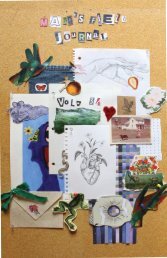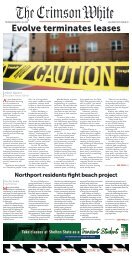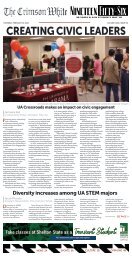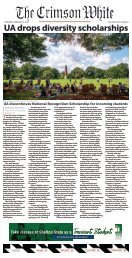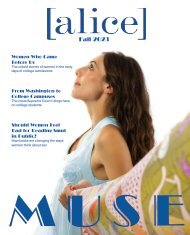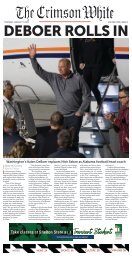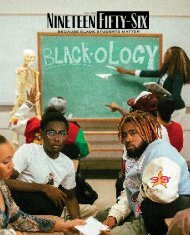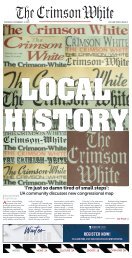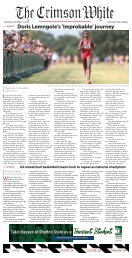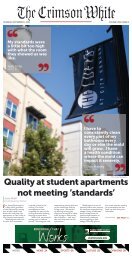Alice Vol. 4 No. 2
Published by UA Student Media Spring 2019.
Published by UA Student Media Spring 2019.
Create successful ePaper yourself
Turn your PDF publications into a flip-book with our unique Google optimized e-Paper software.
Capitol Park<br />
At one point, the city of Tuscaloosa served as the Alabama<br />
capital. From 1826-1846, Tuscaloosa boasted a picturesque<br />
capitol building. The building was built in the Greek revival<br />
style, complete with three wings and an expansive rotunda. The<br />
building was only used as the Capitol Building for a few decades<br />
and was later leased and used by Alabama Central Female College.<br />
However, in 1923 the building was burned to the ground during a<br />
fire which was started by routine maintenance repairs gone wrong.<br />
Today, the site of the ruins is known as Capitol Park and can be<br />
found on Sixth Street. The statuesque ruins create a haunting-yetcaptivating<br />
scene and are ideal for peaceful observation.<br />
Paul R. Jones Museum<br />
Also located on Sixth Street, this local museum houses the<br />
Paul R. Jones collection. The collection is composed of more<br />
than 1700 pieces of African American art, and is said to be one of<br />
the largest collections of African American art in the world. The<br />
collection is special partly because of its mix of art by both well<br />
and lesser known artists. The museum frequently collaborates<br />
with local elementary schools, striving to teach students about<br />
the importance of art in an exciting and educational environment.<br />
Paul R. Jones Museum frequently presents exhibitions to the<br />
public, showcasing artwork that celebrates black culture and<br />
artistic achievement. The museum is open to the public weekdays<br />
from 9 a.m. to 5 p.m.<br />
The Murphy-Collins House/Museum<br />
This quaint two-story green home is located on Bryant Drive<br />
and serves as a historic relic frozen in time, as well as a museum<br />
of African-American history. According to the Tuscaloosa<br />
County Preservation Society, the home was built in the 1920s<br />
by Tuscaloosa’s first black mortician Will J. Murphy. The home<br />
was built using brick and included other materials salvaged from<br />
The Old Capitol Building remains. The museum, although small,<br />
includes a surplus of artifacts and materials to help one gain<br />
insight into the past. The museum is open to the public Tuesday-<br />
Friday, 10a.m- 3p.m.<br />
Old Tavern Museum<br />
Originally built in 1827, this building originally served as<br />
an inn and tavern and was located on a stagecoach route which<br />
passed through Tuscaloosa. One of the oldest hotels in the state,<br />
the inn served as a resting place for soldiers, politicians, and other<br />
important folks. The inn was occupied as a private residence by<br />
several different families until it was restored in 1964 and later<br />
opened as a museum. Located near the ruins of Capitol Park,<br />
Old Tavern museum is a quintessential part of the history of<br />
Tuscaloosa. Old Tavern Museum is open daily for guided tours<br />
Tuesday- Saturday at 10:30 A.M.<br />
The town of Tuscaloosa is shaped by the stories of its people<br />
and it’s land. Visiting local museums and historic landmarks can<br />
be sacred, almost like stepping back in time. History is sometimes<br />
wonderful and sometimes horrible, but all stories are worth<br />
recognizing in reverence of those who came before us. Every town<br />
has a story, and Tuscaloosa’s story is one worth knowing!<br />
90 <strong>Alice</strong> Spring 2019


